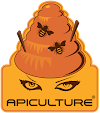Friday, February 26, 2010
Advise from Cindy Bee at the last MABA for new beekeepers
Cindy Bee discussed what’s going on in the hive currently, and told the audience that when temperatures rise to the 50’s, feed the bees a 2:1 syrup (that’s 2 parts sugar; 1 part water) Feed the bees internally inside the top cover, either on top of the frames or on the inner cover.
For those people getting their first nucs this spring, never put the bees on the ground. Have the hive ready prior to the arrival of the nuc. Keep the bees in a cool place until you are ready to put them in the hive. You install the bees just before dark.
Monday, February 22, 2010
Compost and the small hive beetles.
A couple of days ago when I was was at the DHS hive to feed I pulled out the bottom board to look for clues as to what was happening inside. Lots of large pollen balls, some mites (just some), very white wax bits and other various trash was found, along with about 25 small hive beetles. I have never had a beetle problem before and was hoping that this was just an isolated time.
Yesterday Curtis Gentry said that small hive beetles like melons. I didn't think much of it, but ttonight reading a year in the apiary by Cindy Bee, Stop composting: This sounds like an unfriendly thing to do to the Earth, but vegetable clippings and especially fruit and melon rinds draw small hive beetles. I limit my compost pile to coffee grounds and crushed egg shells. Bingo!
DHS has a large pile of compost, this hive is going to require lots of beetle management. I will put in AJ beetle eaters tomorrow. Hope that takes care of it.
Yesterday Curtis Gentry said that small hive beetles like melons. I didn't think much of it, but ttonight reading a year in the apiary by Cindy Bee, Stop composting: This sounds like an unfriendly thing to do to the Earth, but vegetable clippings and especially fruit and melon rinds draw small hive beetles. I limit my compost pile to coffee grounds and crushed egg shells. Bingo!
DHS has a large pile of compost, this hive is going to require lots of beetle management. I will put in AJ beetle eaters tomorrow. Hope that takes care of it.
What are the bes visiting this time of year?
Curtis Gentry was kind enough to answer this question for me.
there could be other stuff too -- this is what comes to mind first --
as you might note, pollen color can range quite a bit as there are often multiple species in many of these listings -- i would suspect the avocado green is likely alder or some species of maple (there are several species of maple out there with red maple being the earliest to bloom which tends more toward yellowish/creamish, as i recall -- the approach to verify this would be to find a bee collecting pollen on the respective plant and compare -- there is an alder shrub near the apiary in the Oakhurst Garden -- the Bee Team will look tomorrow --
as you might note, pollen color can range quite a bit as there are often multiple species in many of these listings -- i would suspect the avocado green is likely alder or some species of maple (there are several species of maple out there with red maple being the earliest to bloom which tends more toward yellowish/creamish, as i recall -- the approach to verify this would be to find a bee collecting pollen on the respective plant and compare -- there is an alder shrub near the apiary in the Oakhurst Garden -- the Bee Team will look tomorrow --
Sunday, February 7, 2010
Larvae on the porch
I noticed a larvae on the porch, for whatever reason they didn't like her. The small cell/natural cell camp would say that this larvae had a mite so they chewed her out. I personally didn't see a mite, but didn't get much of a chance to look before she was scooped up and taken off by the mortician bee. Spring is around the corner, I can feel it.
Subscribe to:
Posts (Atom)



